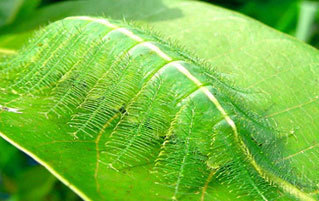The 6 Stealthiest Disguises in the Animal Kingdom

Plenty of animals rely on their ability to hide. There's no shame in your cowardice, non-human friends: Nature is a harsh and unforgiving hellhole -- we'd hide too. But some creatures are so good at blending in to their environment that it goes beyond mere camouflage and turns into a kind of performance art. We've shown you a few of them before. Here are even more critters that could very well be in front of you right now -- if you are reading this from a desert, a swamp, or the bottom of the sea, that is.
(Luckily, there are no terrible spiders that look exactly like computer mice. Or...are there?)
The Fruit Fly That's Got a Posse
Images of ants -- or possibly jumping spiders -- appear to have been airbrushed onto Goniurellia tridens' translucent wings, much like a WWII fighter plane, or the hood of a Pontiac. And they don't just "kind of" look like ants or jumping spiders -- like when the narrator in a nature documentary tells you some bullshit fish has a "terrifying face" because of its measly butt-spots. Look at 'em: Those are downright artistic portraits of its own friggin' predators on its wings.

The fly itself's still ugly as fuck, but those wings are exquisite.
Why are these bugs sporting wing tattoos? Is it ironic, like a hipster with a finger mustache? Did jumping spiders save their lives back in 'Nam? Was it some sort of ant initiation? Without an informant in one of the major ant gangs, we can't know for certain (and there is some doubt that the shapes are even intentional), but it's been proposed that the fruit flies are trying to scare off potential predators by making it appear as though they're already being eaten, are surrounded by dangerous creatures, or are the dangerous creature themselves. Any way you cut it, the lesson is simple: "I'm more trouble than the meal is worth, homey."

"The last two who tried wound up dead and nailed to my ass."
This kind of things isn't exactly novel. In fact, there are all kinds of different fruit flies with weird wing markings that they'll wave at spiders to trick them into backing down, thus earning the species their nickname "the frontin'est motherfuckers in nature."
Moss-Mimicking Walking Sticks Are Forest "Ghosts"
What you're looking at up there is the moss-mimic walking stick of the order Phasmatodea. "Phasm" is derived from the Latin word for "apparition" or "ghost," which is fitting. These things are so good at looking like a random piece of jungle schmutz that we're having trouble picturing how they were discovered in the first place. Did some hapless explorer just go around poking everything in the jungle and naming the stuff that moved?

If it didn't move, it'd probably just be some stupid moss that cures cancer.
Trychopeplus laciniatus lives high up in the cloud forests of Costa Rica, and stakes its entire existence on not looking like what it is. They come in many varieties: There's a hulking species from off the coast of Australia that looks more like a sausage than a stick, and even a flying, thorn-covered one that menacingly waves its ass in the air to trick you into thinking it's a scorpion. Of course, the illusion falls apart a bit if you get an extreme close-up of our mossy little friend:

Just a harmless creature like you or me.
Some bugs achieve a similar effect by piling bits of random crap on their back, but everything you see on moss-mimic walking sticks are all parts of their chitinous exoskeleton. They can't fly, they move very slowly, and are in all likelihood quite stupid. But none of that matters when your own mother can't tell the difference between you and forest rubbish.
Dead Leaf Moths Are Pretty Much Exactly as Advertised
While moths might be generally thought of as the lowbrow, hillbilly cousins of butterflies, a few of them do have some fancy tricks up their sleeves. For example:

You will step on it, to hear the satisfying *crunch*.
We swear there is a moth in the above photo. Uropyia meticulodina, in fact -- the Chinese moth that's a dead ringer for dead vegetation. It goes far beyond mere pattern replication: Look at the shadows, the veins, the curling effect -- that is a normal-shaped moth, the wings are not curled up around itself or anything. It's all just a natural optical illusion worthy of M.C. Escher.
Of course, the illusion falls apart a bit once the moth opens up its wings to fly around. Just like Escher drawings, the dead leaf moth relies on precise angles of viewing to trick the eye, and its disguise pretty much only works in profile. Still, we'd like you to imagine yourself executing a flawless autumnal cannonball into a pile of leaves, only to have them all flap away right before you hit. You would never trust this world again.
Bargibanti's Seahorse Is One With the Coral

Because Bargibanti's pygmy seahorse stands a whopping 2 centimeters (0.79 inches) high, it's one of the world's smallest members of an already adorably tiny species. Look at him!

And is that a baby bump we see?
If you're not already picturing Ant Man slapping some tiny reins on that sucker and riding it about, well -- you are now. Unfortunately, its diminutive size means the pygmy seahorse has got its work cut out for it in the defense department. Luckily, its ability to perfectly camouflage itself against gorgonian coral (where it lives) also makes it one of the hardest creatures to spot. In fact, the species was discovered only after scientists began sorting through collected coral specimens and stumbled across the tiny seahorses stuck along the coral's branches.
Their bulbous tubercles (or big, colored moles, for us non-thinky-word types) match the color and shape of the pygmy's host coral exactly, while the body matches that of the coral's stem. There are even two color variations in the species: gray with red tubercles and yellow with orange tubercles.

Opposing subspecies engage in bitter, adorable turf wars.
The color scheme of the seahorse depends on that of the coral it hangs on -- because, come on, establishing a color palette is the first rule of interior decorating. What seahorse doesn't know that?
The Common Baron Caterpillar Is Invisible on Leaves

This is a Euthalia aconthea, or common baron butterfly caterpillar.

Its legs have legs because don't ask.
Well, that's the opposite of subtle. It's like a neon sign advertising an all-you-can-eat-me buffet. Now take a look once it's positioned itself just right on a leaf.

Unless you like eating mango leaves, it's safe forever.
Native to India and Southeast Asia, the common baron caterpillar, much like pink video game mushball Kirby, eats the leaves of mango trees and then becomes them. It aligns those fuzzy-TV-antennae-looking appendages with the outer veins on the leaf, and then adjusts the stripe down the middle of its body until it matches up perfectly with the midrib. Sure, that poor bastard above has a handful of backwards appendages, but give him a break -- he's doing pretty well for a stupid caterpillar. Despite his half-assing it, looking at him from above or from a distance, you'd never know he was there.
Even from the sides it's easy to miss the caterpillar in this picture:

Just a tumescent leaf. Nothing to see here.
As advertised, these butterflies are common and are often found (assuming you can find them) in urban areas. So the next time you're walking around a city park in Singapore, you'd better think twice about stealing a mango. No, not because of the caterpillars -- they're harmless -- but the authorities cane the shit out of you over there for graffiti. You'd probably get bull-whipped for grand theft mango.
There is a spider in that photo.
There are, perhaps, many spiders in that photo. Who could tell?
Proving yet again that venturing outdoors without proper footwear is the sole providence of drunkards, hippies, and fools, we give you Ocyale guttata. This species of wolf spider blends so seamlessly into the type of gravel common in children's sandboxes and the shower areas of public beaches that you'll likely never even know one's around until it takes your child and/or feet.

On the driveway, no one can hear you scream .
Wolf spiders are the nomadic serial killers of the spider world, and you won't find them lurking in a corner or hiding away in a dark tool shed like cowards. They spin no webs, preferring to prowl the open ground looking for prey to throttle. The females don't let a little thing like childcare slow them down, either -- they stuff their eggs into a sac and drag it around like a nightmarish Baby Bjorn until it's time for them to hatch. Thousands of little invisible roving spiders. Now, look back up to the first image in this entry. Try to spot it. Do your best.
Took you a few seconds, right? How many seconds, exactly, do you think the spider needs?

Spiders don't know how to count. They don't need to.
This is your one and only warning: DO NOT TRUST THE LITTERBOX.
Monte Richard is a slumlord who sometimes writes about slumlording. E. Reid Ross is a columnist at Man Cave Daily, and the proud father of a brand new baby Twitter account that you can coo at here. Carly Brooke is the animal-obsessed author of The Featured Creature, where little-known species become known. You can follow her on Twitter here.
Always on the go but can't get enough of Cracked? We have an Android app and iOS reader for you to pick from so you never miss another article.
Related Reading: Mother Nature hasn't emptied her costume bin yet. Check out these frogfish who hunt with fake lures. And then there's this spider who hides as bird shit. Tired of sneaky animals? Check out the craziest disguises in the history of war.




